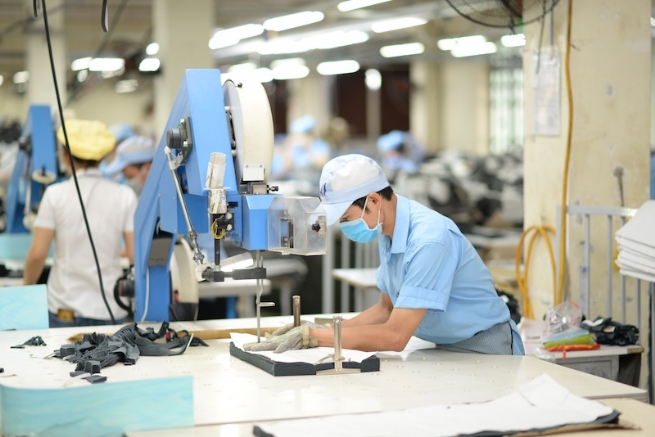TextIle and garment likely to face more difficulties
In the last four months of 2022, the textile and garment industry will have to face enormous challenges like increasing raw material costs, weakening purchasing power, high freight rates and inflationary pressures. The world market is forecast to experience unpredictable fluctuations affecting the business profits of textile companies.

Most importers of Vietnamese textiles and garments are upmarket and fastidious and they impose strict requirements on quality, product safety, environment, recycled content and labor standards.
Medium-term pressures
Rising inflation in the United States and Europe caused food prices to skyrocket and shrink the purchasing power of consumer goods, including apparel and this is forecast to reduce orders in the last six months of 2022. Some garment companies said that U.S. customers have shortened the order time from six months to three months and some even canceled their orders due to high inventories. Orders for the fourth quarter delivery have slowed down amid inflation concerns.
Hardships are growing for the textile and garment industry as input prices, gasoline prices and shipping costs continuously break their highs, resulting in rising production costs. A representative of Song Hong Garment Joint Stock Company said that a 19.1% rise of cotton prices and a three-time growth in freight rates pushed up its domestic production costs by more than 20%. Moreover, the euro-dollar exchange rate being at a 20-year low also considerably affected the revenue of exporters.
The biggest concern for the textile and garment industry is post-COVID-19 competitive pressures, said Mr. Truong Van Cam, Vice President and General Secretary of the Vietnam Textile and Apparel Association (VITAS). The Vietnamese textile and garment industry is facing fierce competition from big rivals like China, Bangladesh, Turkey and India. In the domestic market, it must also compete fiercely with major foreign brands already present in the country.
According to data, the U.S.'s imports increased by 40% in the first and second quarters, but Vietnam's stateside shipments looked up only 26%, compared to over 40% of Bangladesh, Pakistan and other nations. Vietnam's market share in the U.S. contracted from 19.3% to 18.6%. Although it still held the second largest share, pressures on Vietnamese businesses are more obvious, he said.
Competitive pressures on the textile and garment industry are also clearly represented by Vietcombank Securities Company (VCBS) in a recent market report, which noted that Vietnam's textile and garment industry has faced signs of price pressures after Chinese cheap supplies were disrupted. The U.S. tends to increase imports from countries with lower prices than Vietnam. Currently, Vietnam and Southeast Asian countries mainly export PSF short fiber (including recycled and primary) to China, but this PSF fiber market is in increasingly stiff competition and China's PSF fiber imports from South Africa and Nigeria soared rapidly.
Mr. Cam said, most importers of Vietnamese textiles and garments are upmarket and fastidious and they impose strict requirements on quality, product safety, environment, recycled content and labor standards. World trends are also changing, moving from fast fashion to sustainable fashion (increasing product life, recyclability and carbon tax).
Agreeing with VITAS's representative, Ms. Nguyen Hoang Thuy, Head of the Vietnam Trade Office in Sweden, said the EC has recently presented an amendment to the Eco-Design Directive in order to set legal requirements for different product categories. In particular, textiles and garments are among the first to comply with eco-design criteria.
Traceability requirements of cotton, fabric, yarn or textile greening from new-generation free trade agreements (FTAs) are also challenging Vietnamese textile and garment companies. The introduction of many new nontariff policies will produce a medium-term impact on the textile and garment industry. Companies need to be prepared for the enforcement of such policies in Europe and the US, including green production, recyclability and circularity factors. For example, the EU has stricter requirements on the circular economy, aiming to reach waste neutrality by 2050. Vietnam is committed to reducing methane emissions by 30% by 2030 and its textile and garment companies need to stick to this roadmap.
The total solution in need
The government will soon approve the "Strategy for TextileGarment and Leather-Footwear Industry Development to 2030, with a vision to 2035" to facilitate the formation of large industrial parks with centralized wastewater treatment facilities powered by advanced technology and green technology to attract investment fund for textile dyeing, clear fabric supply bottlenecks for garment export to meet origin requirements for FTA tax incentives, said Mr. Cam. At the same time, VITAS will also propose removing spot import tax payment requirement for goods used for export production.
He advised that businesses need to understand changes in domestic and international markets to find workable solutions, and actively adapt to rapid transformation when global purchasing power weakens. Besides, the textile and garment industry needs to build a value chain link in the region, especially with countries in the FTA community and the ASEAN chain link.
To meet strict requirements from importers, it is necessary to come up with a sustainable development strategy, meet criteria and certification of origin, environmental assurance, energy saving, recycling and product shelf-life prolongation in an ecological way. In addition, businesses need to apply scientific and technological advances and automation solutions, especially in spinning, textile, dyeing and garment management.








